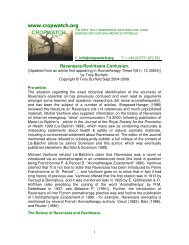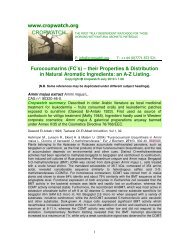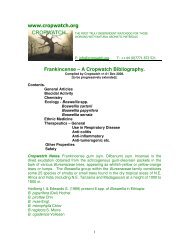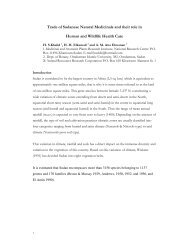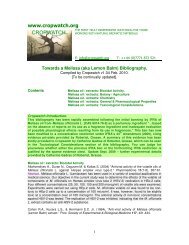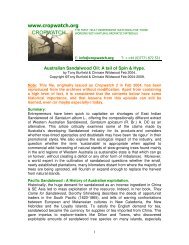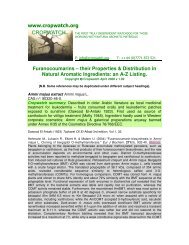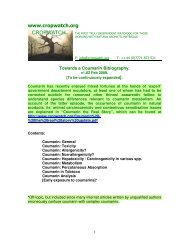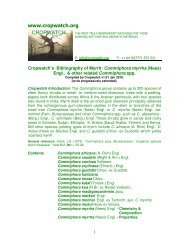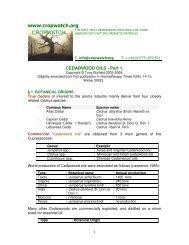Sandalwood Biblio - Cropwatch
Sandalwood Biblio - Cropwatch
Sandalwood Biblio - Cropwatch
Create successful ePaper yourself
Turn your PDF publications into a flip-book with our unique Google optimized e-Paper software.
Thai <strong>Sandalwood</strong><br />
Timorese <strong>Sandalwood</strong><br />
Unclassified Articles on <strong>Sandalwood</strong><br />
Australian <strong>Sandalwood</strong>s.<br />
<strong>Cropwatch</strong> comments: Australia has two commercially important <strong>Sandalwood</strong><br />
spp. (Santalum album & S. spicatum), and a number of other <strong>Sandalwood</strong> spp. of<br />
more minor economic importance (such as S. acuminatum, S. lanceolatum, and<br />
S. murrayanum).<br />
Biocidal Properties of Australian <strong>Sandalwood</strong>s<br />
Ritchie S.A., Williams C.R. & Montgomery B.L. (2006) "Field evaluation of New Mountain<br />
<strong>Sandalwood</strong> Mosquito Sticks and New Mountain <strong>Sandalwood</strong> Botanical Repellent against<br />
mosquitoes in North Queensland, Australia." J Am Mosq Control Assoc. 22(1), 158-60. Abstract.<br />
The mosquito repellent efficacy of New Mountain <strong>Sandalwood</strong> Mosquito Sticks (containing 0.5%<br />
w/w essential oils) and New Mountain <strong>Sandalwood</strong> Botanical Repellent (containing soybean and<br />
geranium oils) was assessed. Tests were conducted in the field with 4 volunteers in a wooded<br />
area near Cairns, North Queensland, Australia. Predominant biting species were Verrallina<br />
funerea and Ve. lineata. A pair of burning Mosquito Sticks immediately upwind of the subject<br />
(acting as an area repellent) provided a 73.1% mean reduction in mosquito landing and probing<br />
over the 3-h test period. The Botanical Repellent and a DEET-based control were both 100%<br />
effective in preventing mosquito probing for 3 h. These data are consistent with other studies of<br />
area repellents in that such products provide significant protection from mosquito bites, albeit<br />
inferior to the protection provided by topically applied repellents.<br />
Spafford H., Jardine A., Carver S., Tarala K., Van Wees M. & Weinstein P. (2007) "Laboratory<br />
determination of efficacy of a Santalum spicatum extract for mosquito control." J Am Mosq<br />
Control Assoc. 23(3), 304-11. Abstract. The activity of QN50, a sequiterpene alcohol derived from<br />
Australian sandalwood (Santalum spicatum), was tested for its effectiveness against larvae of 2<br />
mosquito species (Culex molestus and Aedes camptorhynchus [Diptera: Culicidael), nymphs of 2<br />
species of water boatmen (Micronecta robusta and Agraptocorixa [Hemiptera: Corixidae]),<br />
immature Daphnia sp. (Crustacea), and mosquito eggs (Cx. molestus). In a series of laboratory<br />
bioassays, field-collected mosquito larvae, eggs, and immature corixids and daphnids were<br />
placed in beakers with either QN50, methoprene or source water only (control). The mosquito<br />
larvae exposed to QN50 had reduced survivorship and average longevity relative to the control<br />
and to methoprene at most concentrations used in this study. The hatching rate of mosquito eggs<br />
was unaffected by methoprene or QN50. Corixid nymphs and daphnids experienced high<br />
mortality in both methoprene and QN50 relative to the control, but there was no difference in the<br />
effect between the compounds. The results of this preliminary study suggest that further research<br />
into the mode of action and efficacy of QN50 as a potential alternative to methoprene for<br />
mosquito abatement is warranted.<br />
Chemistry of Australian <strong>Sandalwood</strong>s<br />
Adams D.R., Bhatnagar S.P. & Cookson R.C. (1975) “Sesquiterpenes of Santalum spicatum”<br />
Phytochemistry 14(5-6), 1459-1460.<br />
Birch A.J., Moslyn K.M.C. & Penfold A.R. (1953) "The sesquiterpene alcohols of Eucarya spicata<br />
Sprague & Summ." Aust. J. Chem 6, 391-394. <strong>Cropwatch</strong> comments: Eucarya spicata Sprague<br />
& Summ. Is the outdated botanical name for Santalum spicata R.Br.<br />
Birch A.J., Chamberlain K.B., Moore B.P. & Powell V.H. (1970) “Termite attractants in Santalum<br />
spicatum.” Australian Journal of Chemistry 23(11), 2337-2341. Abstract. The oil of Santalum<br />
spicatum (R.Br.) A.DC. has been fractionated to yield 10-cis- (1) and 10-trans-2,6,10-<br />
trimethyldodeca-2,6,10-triene (2). These compounds have been synthesized by reduction of a<br />
2





